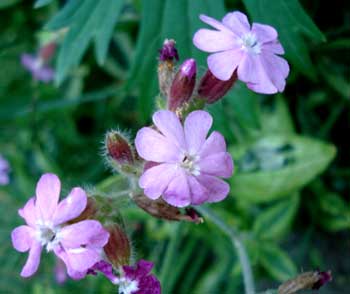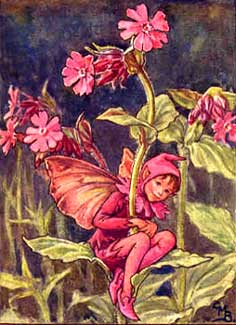
'Clifford Moor'
Variegated Catchfly or
Morning Campion
"Each with a lance, erect & tall,
A falchion, & a buckler small,
Stood by their Sire, on Clifford Moor,
To guard the Standard which he bore."
-William Wordsworth
(1770-1850)
(1770-1850)
 Silene dioica (formerly Melandrium rubrum & Lychnis dioica) is a semi-evergreen perennial that fits in the garden in pretty much the same locations as bugloss but with persisting foliage.
Silene dioica (formerly Melandrium rubrum & Lychnis dioica) is a semi-evergreen perennial that fits in the garden in pretty much the same locations as bugloss but with persisting foliage.It might also mix well with hellebores or hostas though needing slightly more moisture than either. It doesn't show slug or insect damage as readily as hostas, but renews itself better as the year progresses.
It thrives best in zones 5 through 8. It prefers bright shade or a woodland edge setting or at the foot of hedgerows, but can tolerate full sun, especially when gardened further north. The species is native to northern Europe all the way to the subarctic, hence is very cold-hardy & in temperate gardens where it is often vibrant right through winter, since its notion of "real" winter never quite arrives to shut it down.
 A well established clump can tolerate some dryness but to bloom best in summer, moderate or medium moisture is best. It needs good drainage.
A well established clump can tolerate some dryness but to bloom best in summer, moderate or medium moisture is best. It needs good drainage.The species has escaped cultivation in Canada & the United States to naturalize in the Pacific Northwest, New England, & Great Lakes region. But the variegated cultivar 'Clifford Moor' is not as likely to be invasive.
The species can be two feet tall but 'Clifford Moor' is a tight clump a foot tall with flower stems fifteen or eighteen inches tall. Stems can be longer but tend to flop with a semi-creeper appearance, so not really tall.
Though the species' common name is Red Campion, Red Catchfly, or occasionally Red Cockle, it's definitely pink, with the darkest strains approaching magenta but never actually red. Some have a red center to the mainly pink flower, hence the common name Red Bird's Eye. 'Clifford Moor' is a paler pink than the species.
According to John Gerard writing in the 1600s, this was one of the flowers called "bachelor buttons," for the flower has a bladder at the rear that gave it the look of a specific type of button of the era. Red Campion was also known as "Pudding Sack" due to these bladders, just as White Campion was known as "Bladder Campion" & "Fat Bellies."
On the Isle of Mann S. dioica is known as Fairy Flower, being associated with the Fair Folk. It was ill luck to pick one because it would draw down the wrath of the fairies. A more innocuous Red Campion Fairy is shown above, as drawn by Cicely Mary Barker.
In folklore, the fairies used Silene to protect their honey stores, as did the Goddess Flora, Queen of Fairies, in the children's poem Flora's Gala (1808) by Maria Flaxman & William Roscoe:
"Whilst Mushrooms & Mosses the company grac'dCatchfly is most widely applied name for the genus Silene, alluding to sticky stem & calyx that can trap tiny insects that might've gotten nectar without pollinating the flower, so that there'll still be nectar to reward a larger pollinating insect, or which causes a fly to struggle to get loose from the flower resulting in fuller pollination. Its preferred pollinators appear to be moths & butterflies, whose proboscis permits them access to the nectar without hindrance of the stickum.
The Catchfly as guard of the Honey was plac'd."
 The name Silene is ancient, derived from the Greek sialon meaning "saliva" & alludes, like Catchfly, to the sticky calyx.
The name Silene is ancient, derived from the Greek sialon meaning "saliva" & alludes, like Catchfly, to the sticky calyx.One or another species of Silene or a similar plant with sticky components, &/or which self-seeded into vineyards, was likely at one time sacred to a dying-&-reborn divinity whose seasonal death resulted in the birth of grains, fruits, or flowers.
In this case the divinity would've been Silenus (Silenios), whose worship was significant on the isle of Crete where so many flower-cults originated. In the tale of King Midas feting Silenus for five days & nights, there is a clear lingering recollection of a Festival of Silenus, celebrating the fermentation of the wine, which likely lasted for five days during the time of Minoan high culture.
He was the teacher & grandfather-figure to Dionysios, a wild priestly figure devoted to the Goddess Cybele. He fostered & taught grape cultivation & winemaking to the God of Wine himself. Silenus perhaps represented the froth of wine, or he was the aged form of Dionysios himself, notoriously a drunkard yet honored for his wisdom, there being an ancient belief throughout the mideast (& frequently encountered preserved in the Talmud) suggesting that wine opens gateways of mystical intelligence. In the Gnostic Teachings of Sylvanus the teacher seems to have chosen his name well, asking, "Why do you drink stale water, though sweet wine is available for you?" further identifying wine with "Wisdom, your Mother."
Though jovial by nature, the philosophy of Silenus in Greek myth seems gloomy, though perhaps he merely upraised "the transience of life" as not tragic at all. He taught Dionysios & King Minos that Man is happiest if never born into the material world, but if he is born, he is happiest who dies soonest. A god that died annually & returned as spring flowers might be expected to have such a philosophy. He is also to some degree an avatar of the Moon, with a name homonymous with Selene the Moon-goddess, hence (in Sophocles' Ichneutai) an assistant in reclaiming the stolen Cattle of the Moon.
To be kindly toward aged drunkards was thought to bring blessings to the household through the appreciation of Dionysios. Silenus & his band of Selini were woodland spirits, notably lewd, skillful with flute & lyre, in many ways resembling the Green Man. Sometimes Silenus was identified as the oldest son of Pan, or the first satyr older than Pan, the son of Hermes.
In Thebes & Phrygia he was also called Marsyas the son of the wine-god Oeagrus or Oeager, & was the half-brother of Orpheus, a signal figure in Orphic religion. Not originally a pot-bellied old man, Thomas Woolner (1825-1892) was perfectly justified in regarding him as more bewitching than "birds, flowers, & the growth of the woodlands wild," beginning his doomful tale thus:
"Silenus, radiant as a summer morn,Silenus's mother was Hyagnis, obscure enough that she is sometimes mistaken for his father in the vague genealogies, called the satyr Hyagnis who sired Marsyas on the Moon-goddess Selene.
Smiling exultant in the might of youth..."
But Hyagnis was a feminine name meaning "Healing Purity" or "Holy Healer," & Hyagnis was most likely a nymph priestess of Cybele & Dionysios, a "wailing woman" or grief-goddess (reflex of Cybele) who wailed at the flaying of her son conducted by Apollo & the Muses. This Hyagnis was the inventress of the double-pipes, having devised diatonic harmony long known as "the style of the mother" because so closely associated with Cybele. The myth of Athena inventing the double-pipe probably arose as a Greek myth to interpret Phrygian images of Hyagnis-Cybele with her cheeks puffed out playing the very flute that later became the instrument of her son, played at his fertility sacrifice.
Silenus was foremost of the woodland Sileni such as resembled satyrs, but were originally ipotanes, such as were part horse or part donkey instead of goat. In Greek vases, Cybele-worshipping maenads are frequently depicted chasing young men who are nearly naked & who have affixed horses' tails into their rear ends. They flee from the rambunctious maenads but if these women capture the horse-tailed lads, they beat the young men with pine staffs, much as Marsyas was bound to a pine tree & flayed alive. This symbolic slaying had erotic overtones in the maenadic reenactments, for it was essentially a fertility event that improved the reproductive health of gardens, woodlands, beasts, & humans.
The icon of Silenus shown on this page, from 460 B.C.E., gives him either goat or donkey ears, but often he is merely a large old man, bald & bearded, riding a donkey in a drunken stupor, or carried about by friendly satyrs. The donkey of Silenus became the preferred annual sacrifice to Priapus, Roman God of Gardens. The Romans called Silenus Silvanus, & to the Etruscans he was Selvans, God of Meadows & Groves, protector of cattle, & whose name meant "of the forests" or sylvan glades.
 The light pink flowers of 'Clifford Moor' are very persistent spring through autumn. It blooms as early as March but certainly by May, flowering most intensely June & July, lasting all summer if not too awfully heat stressed, with rebloom deep into Autumn.
The light pink flowers of 'Clifford Moor' are very persistent spring through autumn. It blooms as early as March but certainly by May, flowering most intensely June & July, lasting all summer if not too awfully heat stressed, with rebloom deep into Autumn.It flowers at least until September or first frost, but blooms in November are not unexpected on Puget sound. The photo by this paragraph is from October, the others from June & July.
Although not widely regarded as an important food plant, several species of Catchfly including S. vulgaris, S. acaulis, S. dioica & others are used regionally as potherbs among gatherers of native wild harvests or as a famine food. The roots of S. dioica have an additional folk-value as a mild detergent acquired by simmering the roots.
There was a baseless folk belief that if you threw Red Campion at a scorpion, it would thereafter be unable to sting. Equally baseless were the array of human ailments, including kidney stones & the plague, Red Campion was alleged to cure.
In many places in Europe this species is considered an unwanted weed & pulled out wherever it self-seeds. But the variegated forms such as 'Valley High,' 'Druett's Variegated,' 'Graham's Delight,' & 'Clifford Moor' are more restrained & the foliage most elegant. 'Clifford Moor' has long dark green leaves with broad bands of greenish gold down both sides, forming a handsome tidy round clump.
'Clifford Moor' is not named for any personage so called. This variegated Catchfly is named for the moorlands of Clifford near Wetherby where a famous battle between the English & the Scots was waged during the Northern Rebellion of 1569.